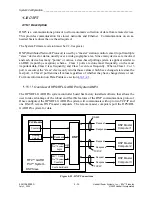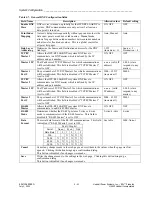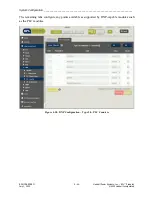
System Configuration __________________________________________________________________
RF-MCGARDPRO
Hubbell Power Systems, Inc.
–
RFL™
Products
July 1, 2022
©2022 Hubbell Incorporated
4-58
To make use of the DNP feature the user must configure the HPS/RFL GARD Pro system
appropriately using the “DNP3 Configuration” web page; Configuration > DNP > General. This
sets up the communication parameters allowing the HPS/RFL GARD Pro system to connect with
other devices.
Once the DNP configuration page is set other parameters such as the “Point list setting” web
pages can be configured.
Note
: DNP will not be functional until at least one DNP point is enabled.
To reduce polling traffic, the GARD Pro can be set to send unsolicited messages to any of the
DNP3 masters. Unsolicited messages are sent when a binary object changes state or an analog
value changes by more than a user adjustable deadband setting. The unsolicited message
capability is disabled by default and must be enabled via an “Enable Unsolicited Messages”
command from the DNP master.
Note:
Since the unsolicited messaging setting of the GARD Pro is not stored in NVRAM, it must be
enabled by the DNP Master each time the GARD Pro is power-cycled."
DNP3 Features
The HPS/RFL GARD Pro system provides the following features to aid managing the system.
4.16.1.2.1 Data Point Refresh Time
In some cases, the refresh rate of DNP points may be slower than the actual event duration. This
means it is possible that events which occur within the refresh time will be missed and not
recorded as a DNP change event.
In the HPS/RFL GARD Pro system the refresh time for SOE Trigger DNP points is 1 millisecond.
For HMI In and HMI Out the refresh time is 50 milliseconds.
For an event to be recorded as a DNP change event, the duration of each state must be a minimum
of 1 millisecond for SOE Trigger points or 50 milliseconds for HMI Out and HMI In.
4.16.1.2.2 Data Point Index manual assignment
Manually assigned data point indexes is provided as an alternative to auto assigned. This requires
the user to manually assign each data point index. Indexes can be freely assigned within an object
type as long as there are no duplicates indexes.
Manual mode also includes a default index assignment option which applies a default index for
each point. Default indexes for points sourced from installed modules, where available, are based
on the slot number and location.
















































